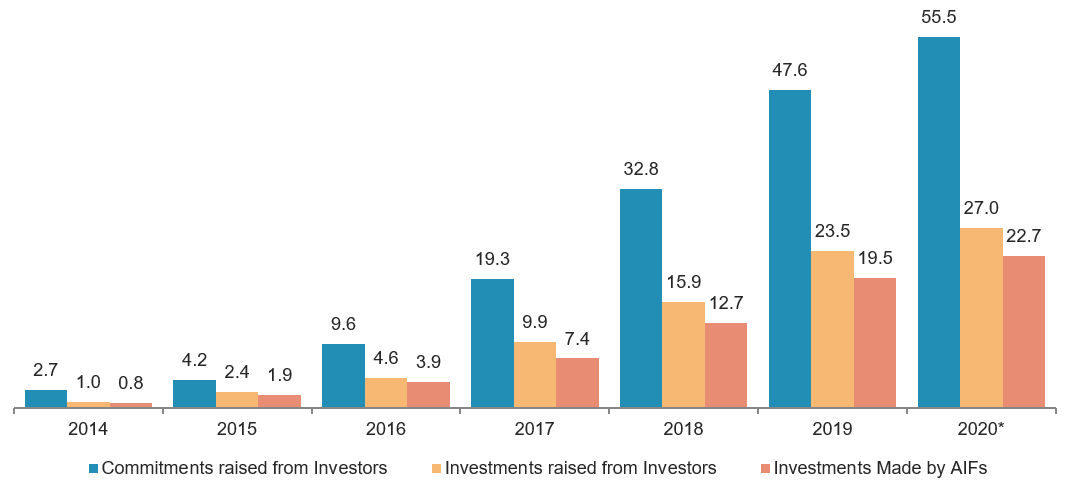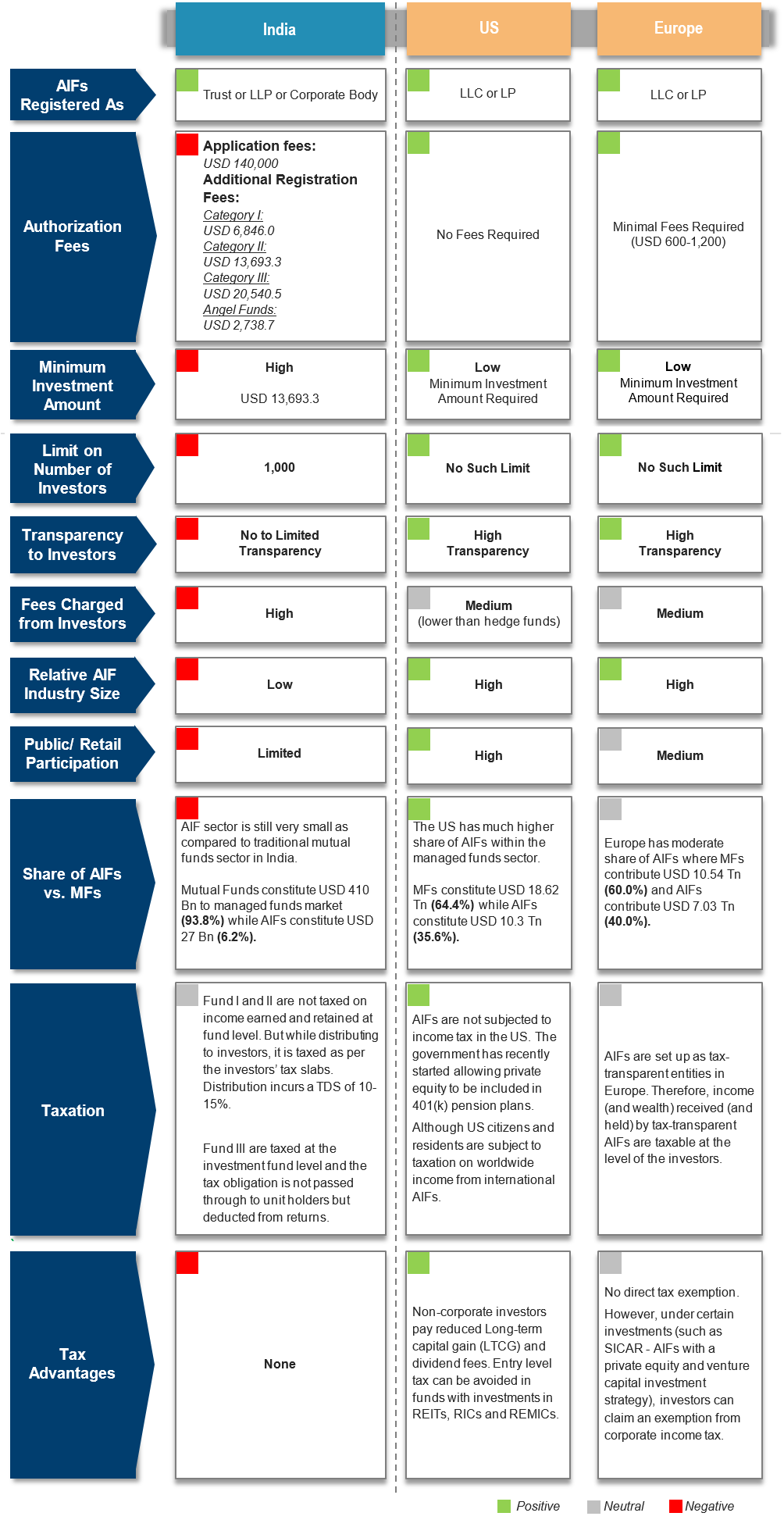Alternative Investment Funds in India - A Comparison with the West
Published on 19 Feb, 2021

India’s alternative investment space is an expanding domain, where investors are investing significantly for ownership and leveraging a higher risk/reward potential. The Securities Exchange Board of India (SEBI) introduced alternative investment funds (AIFs) in 2012, primarily to boost asset classes such as venture capital, private equity, angel, and real estate funds. These funds are mainly intended for investments from HNIs and institutional investors. This article ponders upon the current AIF scenario in India and draws a comparison between the AIF industry in India and in the West (the US and Europe), and how the latter has benefitted from retail participation in the AIF sector.
Alternative investments are financial assets that differ from traditional investment categories such as equities and debt. Alternative investment funds (AIFs) are privately pooled investment vehicles that raise funds through private placements. The collected funds are then invested as per the defined investment policies. Investment avenues include venture capital, private equity, and real estate, among others.
Unlike generic mutual funds (MFs), AIFs are not allowed to invest in equity and debt. Moreover, AIFs in India pool investments only from private, sophisticated investors that can invest large sums.
AIFs Industry Size in India
Investments raised by AIFs reached around USD 27.0 Bn by September 2020, posting a 74.4% CAGR between 2014-20. During this period, commitments for investments reached USD 55.5 Bn (65.5% CAGR) and investments by AIFs in alternative assets reached USD 22.7 Bn (75.2% CAGR).
Cumulative Investment Figures (Figures in USD Bn)

*data till September 2020
Source: SEBI
A cyclic distress of equity and bonds during economic slowdowns has led investors to find new assets to invest in such as alternative classes resulting in increased uptake of alternative investments.
However, AIFs in India are not allowed to make any invitations to public to subscribe to their securities. They are held as privately pooled investment vehicles and must raise funds through private placements only. Although they can launch several schemes under one fund, the scheme must have a minimum corpus (total asset under management) of USD 2.7 Mn; for angel funds the corpus is USD 1.4 Mn.
Minimum Investment Value for investors who want to invest in AIFs is USD 140,000 (USD 34,000 in angel funds) and maximum 1,000 investors can invest in one fund.
AIFs Industry Size in the US
AIF market reached USD 10.3 Tn in 2019 in the US (vis-à-vis USD 23.5 Bn in India). The market is further anticipated to reach USD 14.0 Tn by mid-2023, expanding at a CAGR of 8.0%. The key factor driving the market in the US is increased digitalization which has facilitated private networks to help investors and fund managers to seamlessly monitor their portfolio.
Sector-wise, private equity funds in the US are likely to overtake hedge funds and become the largest alternative asset class in the country.
US allows offering of AIFs as alternative mutual funds which are regulated by SEC and can pool funds publicly. This enables retail participation in the sector which drives large volumes of investments. Also, these mutual funds have higher transparency and are easily accessible due to comparatively low minimum investment amounts.
AIFs Industry Size in Europe
AIF investments were valued at USD 7.0 Tn in the beginning of 2019. The market grew 11% from the previous year, mainly following the launch of new AIFs in 2018. In Europe, professional investors own most of the share of AIFs, despite that retail investors’ share is significant at 16%. The AIFs in Europe predominantly invest in the European Economic Area (EEA) and across a broad range of asset classes.
Sector-wise, fund-of-funds account for maximum share followed by real estate funds, hedge funds, and private equity funds.
Europe’s AIF industry gained traction as it offers lower transaction costs (compared to traditional funds), market volatility mitigation, and the ability to provide high incomes. Also, retail participation along with institutional investors help bring up the volume of AUM.
Comparison Between AIFs Industry in India vs. the West

Suggested Reforms and Conclusion
Increasing retail participation
SEBI can consider reducing the minimum investment amount in accordance with other investment vehicles such as mutual funds to increase retail participation and increase investment in AIF industry.AIFs have historically given higher returns than traditional equity in the US. Increasing retail participation could generate additional avenue for retailers to earn higher-than-equity returns.
Increasing Maximum Number of investors
SEBI can also ease the limit on maximum number of investors that can participate in a scheme. This will help in generation of higher AUMs under each scheme, resulting in greater investment amounts in diverse sectors such as private equity, venture capital, and real estate.Increasing transparency
The SEBI shall introduce regulations to increase the transparency of operations of AIFs, especially on asset classes and areas that can help attract investors. This would assist investors to make better decisions regarding their money and may gain the confidence of both institutional and individual investors.Providing Tax Advantages
The SEBI could provide tax advantages or tax deductions to investors in a bid to scale up investment in AIFs. This would aid in diversifying investments in multiple asset classes and bolstering multiple financial areas.
In conclusion, India’s AIF industry has a huge potential as it has grown exponentially over the past few years, higher than the traditional investment industry. However, growth is stunted due to due to limited investor participation (only HNWIs and institutional investors) and other limiting factors. Therefore, SEBI shall make provisions to encourage retail participation and help the AIF industry generate volume.

